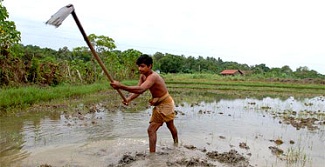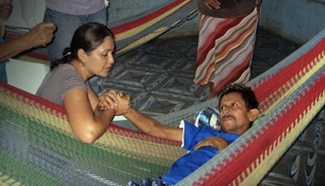
Note to Readers: Monsanto Watch is being spun off as its own publication. If you would like to receive mailings Friday afternoon that include Monsanto coverage and other environmental news, please sign up here. Evidence from a newly released study is linking glyphosate, the prime ingredient in Monsanto's Roundup, the world's most heavily used herbicide, with an epidemic of fatal Chronic Kidney Disease of unknown cause (CKDu) that is afflicting poor farmers working rice paddies in northern Sri Lanka.
The Center for Public Integrity found that CKDu has killed more people in El Salvador and Nicaragua than diabetes, AIDS and leukemia combined, over the past five years on record. In the first stages, loss of appetite or fatigue may occur; advanced stages come on gradually, usually unnoticed, and by then the disease is irreversible. Symptoms of severe kidney damage include yellowing of the eyes and skin and severe muscle cramps. The study, which focused on Sri Lanka, was published in the International Journal of Environmental Research and Public Health. The authors propose that glyphosate becomes extremely toxic to the kidney when it mixes with 'hard' water or heavy metals like arsenic and cadmium, either naturally present in the soil or added externally through fertilizers. Hard water contains metals, such as magnesium, strontium and iron, and minerals such as calcium, along with carbonate, bicarbonate, sulphate and chlorides. The authors describe how glyphosate's half-life can increase from several weeks in normal water to many years in hard water, as it forms hard-to-biodegrade glyphosate-metal complexes (GMCs).
CKDu does not carry the same known risk factors (that is, causes) as chronic kidney disease, which include diabetes, high blood pressure and glomerulonephritis, an inflammatory kidney condition. That leaves some other unknown cause of inflammation or a toxin as the likely culprit. CKDu appeared suddenly in the 1990s in northern Sri Lanka, at about the same time farmers started using glyphosate on their rice paddies. The authors propose farmers develop the disease due to prolonged environmental exposure and bioaccumulation (build up in the body) of GMCs. CKDu is known to be closely associated with sugar cane production as well. Glyphosate is used heavily on sugar cane and sugar beets worldwide to ensure uniform ripening and higher sugar content. To unsubscribe, click here e Wiki | Friends | Editors | Contact Us Copyright © 2014 by Planet Waves, Inc. All Rights Reserved. Other copyrights may apply. Some images used under Fair Use or Share Alike attribution. |

